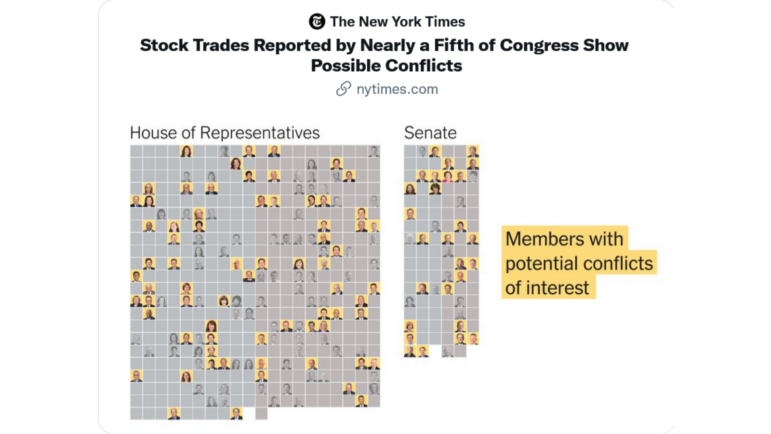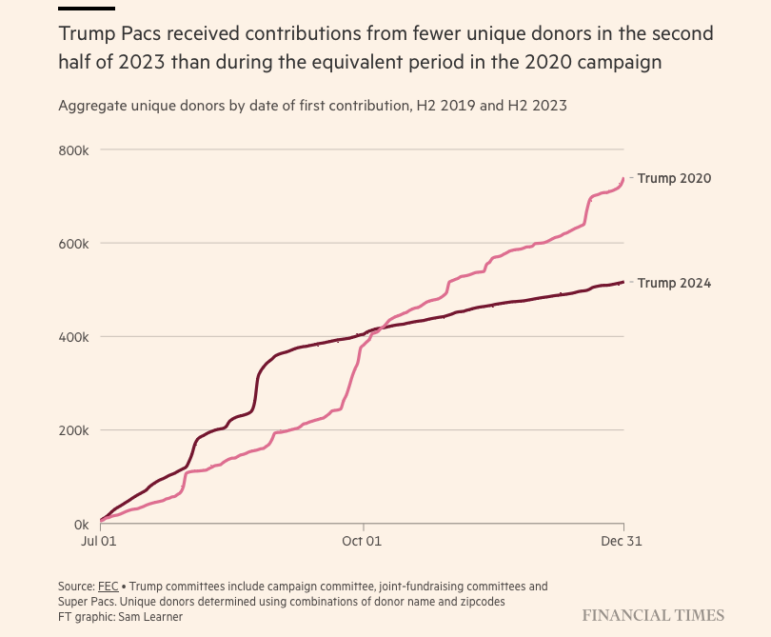

Data Journalism Top 10: Lawmaker Insider Trading, Queen Elizabeth’s Money, Celebratory Gunfire, Russian Bomb Shelters
Read this article in

A New York Times analysis of US Congress stock trades shows nearly one in five had potential conflicts of interest. Image: Screenshot
Potential conflicts of interest among a country’s lawmakers are an important concern for any electorate, as featured stories by The New York Times and Peru’s OjoPúblico demonstrate. Our weekly NodeXL and human curation of the most popular data journalism stories on Twitter also spotlights the history of Queen Elizabeth II’s portrait on banknotes worldwide, an explanatory piece on how so-called celebratory gunfire can be deadly, as well as stories tracking displaced people in the Democratic Republic of Congo and Ukrainian children in institutional care.
Stock Trading Conflicts in US Congress
Members of the US Congress, America’s national legislative body, are allowed to invest in companies and buy and sell stocks with few restrictions. To examine the potential for conflicts of interest, The New York Times analyzed reported trading transactions from 2019 to 2021. By matching these trades with Congressional committee assignments and the dates of specific hearings, journalists were able to identify 3,700 trades made by 97 lawmakers or their family members that could have been influenced by the use of inside information. Read the full story, and peruse the individual findings here.
The Queen’s Cash
The face of Queen Elizabeth II, the British monarch who died earlier this month, has graced the currencies of more than 30 countries and territories across every continent except Antarctica. Canada, a member of the Commonwealth, was the first to feature Elizabeth’s likeness on its $20 bill in 1935, when she was just an eight-year-old princess. The Washington Post ingeniously illustrated, in the form of a banknote, when each country started circulating cash with the late queen’s portrait, and when they stopped, while also asking when her portrait might be replaced by that of her son, King Charles III.
When Celebratory Gunfire turns Deadly
Celebratory gunfire — the shooting of guns into the air to mark a joyous occasion or holiday — is more dangerous than you might realize. Such stray bullets have killed and injured people, and even taken down a small plane. To examine the risks, content marketing agency 1Point21 Interactive ran simulations with different ammunition types and various firing angles to determine how dangerous a falling bullet can be.
Electoral Bingo
Ahead of Peru’s regional and municipal elections next month, Peruvian investigative newsroom OjoPúblico created an interactive for readers to explore the backgrounds of more than 1,700 electoral candidates. The Bingo Electoral project is based on information gleaned from seven databases built by the team’s journalists, data analysts, and developers. The interactive shows readers if candidates have been accused of corruption, have a criminal past, or have potential conflicts of interest with the private sector.
‘The Oldest Government in History’
The US’ state of gerontocracy — a society governed by people significantly older than the majority of the adult population — is getting more pronounced, according to an analysis by financial news site Insider. The media outlet tracked the median age of Congress from the 1800s until the present. It found a sharp increase in the age of members of Congress since the early 1990s, when they “began getting much older, much faster” than the people they were representing. Today, about a quarter of Congress is above 70 years old, the highest percentage ever, whereas in the overall US population, half of the country is 38 or younger.
Displacement in the DRC
The Allied Democratic Forces (ADF), an armed rebel group, has been operating in the Democratic Republic of Congo since the mid-’90s. The presence of the group has caused the displacement of an estimated two million people in the Ituri and North Kivu provinces since 2019, according to a data analysis by the Global Press Journal. Researcher Bennett Hanson collected this data over three years using estimates from the UN Office for the Coordination of Humanitarian Affairs, Open Street Map, Doctors Without Borders, and the World Food Programme.
Tracking Ukraine’s Kids in Institutional Care
According to data from the European Union and UNICEF, there were more than 105,000 children in institutional care in Ukraine at the start of the Russian invasion. Reuters journalists looked at what has happened to these minors over the first few months of war: whether they’ve been sent home to parents and guardians, evacuated abroad or within Ukraine, or if they remain at the same institutions. Also don’t miss: Reuters is sharing their open source code and templates for using Svelte for graphs, scrollytelling, and more.
Analyzing US, UK Income Distribution
A recent opinion column by the Financial Times data journalist John Burn-Murdoch claimed that the UK and the US “are poor societies with some very rich people,” triggering widespread debate on Twitter. To reach this conclusion, Burn-Murdoch compared the income distribution and living standards of people in the UK and US against other countries. He found that the rich in these two countries are exceptionally wealthy, while the poorest are struggling with a standard of living worse than the poorest 14 European countries. Noah Smith, a former Bloomberg Opinion columnist and a former assistant professor of finance, offered a rebuttal online.
Russian Bomb Shelters
Interest in Russia’s bomb shelters, which were mostly built during the Cold War, has revived during the country’s war with Ukraine. According to analysis by the European site of Novaya Gazeta, using data from Russian search engine Yandex, there’s been a surge of internet searches for “bomb shelters” by Russians living in regions bordering Ukraine. It also examined hundreds of court decisions to uncover what happened to the many Soviet-era bomb shelters in the country. It found that many have been turned into private businesses — saunas, beauty salons, bars, and auto repair shops.
Trends in Women’s Pro Basketball
The Women’s National Basketball Association (WNBA) championship in the US concluded last week with the Las Vegas Aces taking home the coveted trophy. Polygraph, a visual storytelling studio within The Pudding, collaborated with Google Trends to find out the key search trends related to the WNBA since 2004. They also examined the top nine searches related to “firsts” in the WNBA, such as “first woman to dunk” or “first Native American WNBA player,” to identify the “trailblazers, the risk takers, the ceiling breakers.”
Thanks again to Marc Smith and Harald Meier of Connected Action for gathering the links and graphing them. The Top Ten #ddj list is curated weekly.
 Eunice Au is GIJN’s program manager. Previously, she was a Malaysia correspondent for Singapore’s The Straits Times, and a journalist at Malaysia’s New Straits Times. She has also written for The Sun, Malaysian Today, and Madam Chair.
Eunice Au is GIJN’s program manager. Previously, she was a Malaysia correspondent for Singapore’s The Straits Times, and a journalist at Malaysia’s New Straits Times. She has also written for The Sun, Malaysian Today, and Madam Chair.
For a look at NodeXL’s mapping on #ddj and data journalism on Twitter, check out this map.









